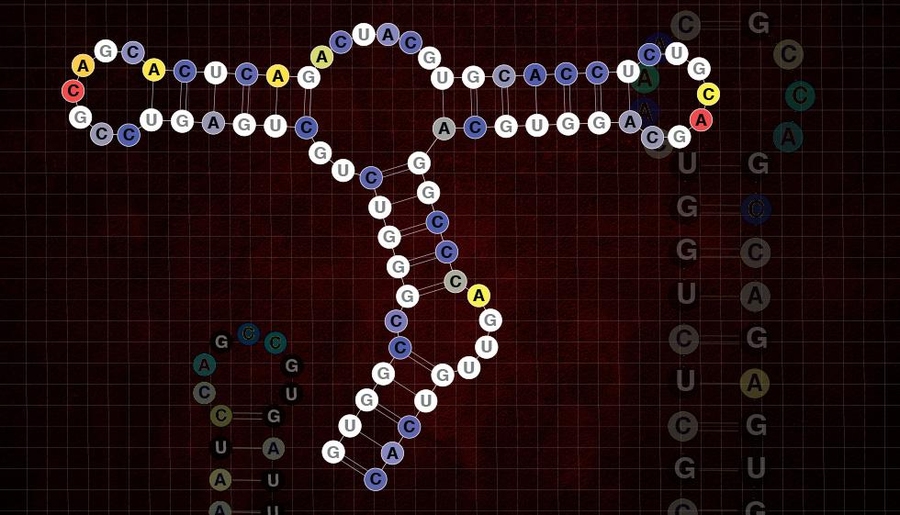DNA stores the information of life, proteins provide the action, and in between sits elusive RNA, which serves both as a database of information and as a molecular machine. RNA is more flexible than DNA, and its three-dimensional structures are more complex than proteins. When studied in the laboratory, RNA bends into so many convolutions that it is nearly impossible to tease out which folds are worthy of scientific inquiry and which can safely be ignored.
New collaborative work from computational biologists at MIT and experimental biologists at the University of California at San Francisco (UCSF), however, is easing that distinction by combining computational and experimental approaches to identifying biologically meaningful RNA folds. The work, published this week in Nature, could open the door to a better understanding of RNA machinery — which ranges from the ribosome, a molecular factory that manufactures proteins, to microRNAs and riboswitches, tiny devices that regulate gene expression, to long noncoding RNAs whose diverse functions are only beginning to be understood.
“There’s much that’s uncertain about RNA,” says co-author Manolis Kellis, an associate professor of computer science at MIT. “Our approach combining computational predictions and experimental measurements can really help us go in the direction of understanding the machinery behind the countless cellular processes that involve RNA.”
Predicting RNA folding
Similar to proteins, RNA folds into 3-D structures that carry out complex molecular functions. To begin studying this RNA machinery, Kellis and co-author Stefan Washietl, a former MIT postdoc who now heads a startup in Vienna, spent several years developing algorithms that predict how strands of RNA are likely to fold. They based their initial models on well-established properties of thermodynamic folding, using parameters that scientists had measured painstakingly over decades.
At the same time, senior author Jonathan Weissman and first author Silvi Rouskin of UCSF were devising a new technique to investigate how RNA strands fold inside a living cell. The technique applies a chemical, dimethyl sulfate, which binds with unfolded strands of RNA, but not with folded strands. To translate the data they gathered using this technique into RNA structures, they employed another algorithm written by Manolis and Washietl that had already been applied to experiments probing RNA in test tubes.
“This work is a major advance in being able to observe RNA folding in its native environment,” says John Rinn, an assistant professor of stem cell and regenerative biology at Harvard University who was not involved in this study. “Now, for the first time, we can globally survey what these structures look like in a cell.”
With this first look at the RNA structures that form in cells, the collaborators could answer a longstanding question: Does RNA fold the same way in cells as in test tubes, as proteins do? They found that, while experimental evidence from studies of RNA structures in test tubes matched Kellis’ computational predictions, observations in living cells did not. Of 23,412 RNA regions they sampled, only 3.9 percent form structures in the cell, compared with 24 percent in test tubes.
“The differences tell us that the system is not obeying the rules of thermodynamics in living cells,” Kellis says. “There is something that the cell is doing to change the folding pattern.”
Most valuable players
Further experimental investigation revealed that RNA inside an energy-depleted cell folds more readily, confirming the hypothesis: Cells are expending energy to allow only certain RNA folds to form, suggesting that those folds must be valuable to the cell.
This insight prompted Kellis and Washietl to study the evolutionary conservation of these structures across related species, to zoom in on the RNA folds likely to be most valuable. “The most interesting RNA folds have either remained unchanged or have changed rapidly over time, suggesting some sort of evolutionary pressure,” Kellis says.
The result is a short list of 259 functionally intriguing RNAs. The collaborators have already confirmed, through further experimental analysis, that three messenger RNAs from this list are likely to perform physiological functions, doubling the number of known functional mRNAs in yeast. “This combination of next-generation sequencing and computational analysis allows us to do biology much more quickly,” Weissman says.
This short list is particularly valuable to Rinn and others who study noncoding RNAs, since structure is at the core of its function. “We now have a lookup table for RNA structure that we could possibly use to start to infer categories of function for noncoding RNAs,” Rinn says. “This technique is a great proof of principle that could revolutionize our understanding of noncoding structures.”
These findings also lend credence to the computational models of RNA folding that Kellis and Washietl had created. “For those RNAs that actually matter, our models are accurate and useful,” Washietl says.
While this study focused on yeast, the researchers have already begun applying these techniques to mammalian cells. “The method is general, so there is great potential to uncover new biology, from yeast to human,” Washietl says.
The research was funded by the Center for RNA Systems Biology, which is supported by the National Institutes of Health, the Howard Hughes Medical Institute, and the National Science Foundation.
New collaborative work from computational biologists at MIT and experimental biologists at the University of California at San Francisco (UCSF), however, is easing that distinction by combining computational and experimental approaches to identifying biologically meaningful RNA folds. The work, published this week in Nature, could open the door to a better understanding of RNA machinery — which ranges from the ribosome, a molecular factory that manufactures proteins, to microRNAs and riboswitches, tiny devices that regulate gene expression, to long noncoding RNAs whose diverse functions are only beginning to be understood.
“There’s much that’s uncertain about RNA,” says co-author Manolis Kellis, an associate professor of computer science at MIT. “Our approach combining computational predictions and experimental measurements can really help us go in the direction of understanding the machinery behind the countless cellular processes that involve RNA.”
Predicting RNA folding
Similar to proteins, RNA folds into 3-D structures that carry out complex molecular functions. To begin studying this RNA machinery, Kellis and co-author Stefan Washietl, a former MIT postdoc who now heads a startup in Vienna, spent several years developing algorithms that predict how strands of RNA are likely to fold. They based their initial models on well-established properties of thermodynamic folding, using parameters that scientists had measured painstakingly over decades.
At the same time, senior author Jonathan Weissman and first author Silvi Rouskin of UCSF were devising a new technique to investigate how RNA strands fold inside a living cell. The technique applies a chemical, dimethyl sulfate, which binds with unfolded strands of RNA, but not with folded strands. To translate the data they gathered using this technique into RNA structures, they employed another algorithm written by Manolis and Washietl that had already been applied to experiments probing RNA in test tubes.
“This work is a major advance in being able to observe RNA folding in its native environment,” says John Rinn, an assistant professor of stem cell and regenerative biology at Harvard University who was not involved in this study. “Now, for the first time, we can globally survey what these structures look like in a cell.”
With this first look at the RNA structures that form in cells, the collaborators could answer a longstanding question: Does RNA fold the same way in cells as in test tubes, as proteins do? They found that, while experimental evidence from studies of RNA structures in test tubes matched Kellis’ computational predictions, observations in living cells did not. Of 23,412 RNA regions they sampled, only 3.9 percent form structures in the cell, compared with 24 percent in test tubes.
“The differences tell us that the system is not obeying the rules of thermodynamics in living cells,” Kellis says. “There is something that the cell is doing to change the folding pattern.”
Most valuable players
Further experimental investigation revealed that RNA inside an energy-depleted cell folds more readily, confirming the hypothesis: Cells are expending energy to allow only certain RNA folds to form, suggesting that those folds must be valuable to the cell.
This insight prompted Kellis and Washietl to study the evolutionary conservation of these structures across related species, to zoom in on the RNA folds likely to be most valuable. “The most interesting RNA folds have either remained unchanged or have changed rapidly over time, suggesting some sort of evolutionary pressure,” Kellis says.
The result is a short list of 259 functionally intriguing RNAs. The collaborators have already confirmed, through further experimental analysis, that three messenger RNAs from this list are likely to perform physiological functions, doubling the number of known functional mRNAs in yeast. “This combination of next-generation sequencing and computational analysis allows us to do biology much more quickly,” Weissman says.
This short list is particularly valuable to Rinn and others who study noncoding RNAs, since structure is at the core of its function. “We now have a lookup table for RNA structure that we could possibly use to start to infer categories of function for noncoding RNAs,” Rinn says. “This technique is a great proof of principle that could revolutionize our understanding of noncoding structures.”
These findings also lend credence to the computational models of RNA folding that Kellis and Washietl had created. “For those RNAs that actually matter, our models are accurate and useful,” Washietl says.
While this study focused on yeast, the researchers have already begun applying these techniques to mammalian cells. “The method is general, so there is great potential to uncover new biology, from yeast to human,” Washietl says.
The research was funded by the Center for RNA Systems Biology, which is supported by the National Institutes of Health, the Howard Hughes Medical Institute, and the National Science Foundation.






